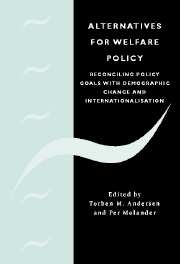Book contents
- Frontmatter
- Contents
- List of contributors
- Preface
- 1 Introduction
- 2 International integration and the welfare state
- 3 The changing age structure and the public sector
- 4 Emigration from the Scandinavian welfare states
- 5 Productivity and costs in public production of services
- 6 Use of fees in the provision of public services in OECD countries
- 7 Privatisation of social insurance with reference to Sweden
- 8 Occupational welfare
- 9 Pathways to retirement and retirement incentives in Sweden
- 10 Social insurance and redistribution
- 11 Assessing the effect of introducing welfare accounts in Sweden
- 12 Taxation in a global economy
- 13 Taxation and education investment in the tertiary sector
- 14 Debt strategies for Sweden and Europe
- 15 Policy options for reforming the welfare state
- Index
- References
2 - International integration and the welfare state
Published online by Cambridge University Press: 22 September 2009
- Frontmatter
- Contents
- List of contributors
- Preface
- 1 Introduction
- 2 International integration and the welfare state
- 3 The changing age structure and the public sector
- 4 Emigration from the Scandinavian welfare states
- 5 Productivity and costs in public production of services
- 6 Use of fees in the provision of public services in OECD countries
- 7 Privatisation of social insurance with reference to Sweden
- 8 Occupational welfare
- 9 Pathways to retirement and retirement incentives in Sweden
- 10 Social insurance and redistribution
- 11 Assessing the effect of introducing welfare accounts in Sweden
- 12 Taxation in a global economy
- 13 Taxation and education investment in the tertiary sector
- 14 Debt strategies for Sweden and Europe
- 15 Policy options for reforming the welfare state
- Index
- References
Summary
Introduction
International integration is a frequently highlighted challenge facing welfare states, not least the extended models developed in Northern European countries. The process of tighter international integration is by some taken to imply that welfare states have to be rolled back, while others point to this as strengthening the need for welfare state activities. These issues are increasingly brought to the forefront in policy debates on the welfare state, but also in many cases shaping views on the pros and cons of international integration.
It is indisputable that international integration is proceeding at a rapid pace and that it changes economic structures, and therefore in turn both the scope and need for welfare state activities. In the increasing amount of literature on these issues it is possible to identify three different lines of reasoning. One view is that the welfare state will have to be rolled back since it will become increasingly difficult to finance welfare state arrangements through general taxation (see e.g. Sinn 1998; Tanzi 2000; Wildasin 2000a). A contesting view is that the welfare state has developed in response to various changes in society including different family structures and gender equalisation, but also risks induced by, among other things, international integration (see e.g. Rodrik 1997, 1998; Kautto et al. 2000). Countries may differ in how far they have proceeded in this development, but they will eventually all encounter these factors, which necessitate an expansion of welfare state activities.
- Type
- Chapter
- Information
- Alternatives for Welfare PolicyCoping with Internationalisation and Demographic Change, pp. 23 - 48Publisher: Cambridge University PressPrint publication year: 2003



